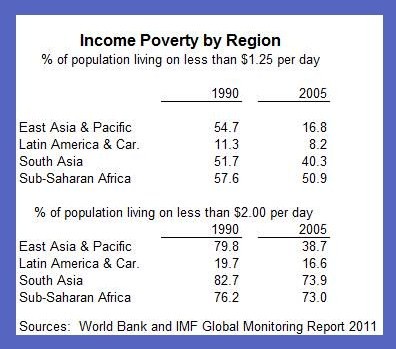Economists care about growth. Governments care about what it can achieve: more jobs and more income for more people. An increasing number of African countries have been growing robustly for more than a decade. But while growth is a necessary condition for poverty reduction and employment creation, is it also sufficient?
When growth first takes off, it is typically associated with steady progress in several dimensions of poverty reduction: incomes rise and countries are able to finance more spending on health and education, which translates into much-needed progress toward the Millennium Development Goals. But after this initial spurt, other questions arise. In particular, a number of countries are increasingly concerned about how inclusive growth is; are the benefits well-spread or do they accrue only to the few?
Inclusive growth that creates jobs and raises income matters not only because of issues of social justice, peace and political stability.
Inclusive growth matters because it can start a virtuous growth circle. The poor typically spend more of their income to meet basic needs, so if a poor person's income rises, they will spend most of it, creating a ripple effect. Rising incomes and rising profits support demand, which in turn fuels more growth in incomes and profits. In addition, production on a larger scale, along with better health and nutrition, improve worker productivity, making products cheaper and more plentiful still.
Studies also suggest that high income inequality, especially in low income countries, inhibits growth.
Two factors may have played a role in limiting the benefits of economic growth:
- In some cases, growth has been concentrated in the natural resource sector. But mining and oil enterprises are capital intensive, meaning they create little domestic employment. They can also be difficult to tax, and only a small share of the profits is retained in the country and used to reduce poverty.

A number of African countries are now taking on the fundamental challenge to bring about more inclusive growth, drawing on the successful programs in other countries with large poor populations, such as Brazil, China and India. Some examples:
- Countries are implementing policies to create jobs by increasing productivity and diversifying economic activity, particularly in agriculture, public infrastructure, such as transportation, water, and energy, as well as regulatory reforms. For example, Mozambique's new poverty reduction action plan increases spending for job-creation in agriculture, while Uganda has earmarked public savings to finance a new hydro-electric project. Tanzania is redoubling efforts to eliminate red tape impeding private enterprise.
- Programs and policy advice to reinforce countries' existing efforts to boost productivity and diversify production, such as processes to identify and select investment projects with widespread returns, as well as simple and transparent rules for starting businesses.
From iMFdirect blog


